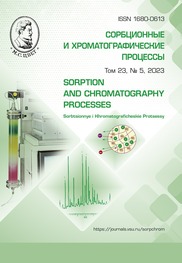Study of the physicochemical characteristics of modified carbon sorbents based on wood waste
Abstract
The use of dispersed wood in the development of methods for producing sorption materials based on it becoming increasingly economically feasible, however, to solve practical problems, materials with a certain porous structure and surface chemistry are required. This article presents a study of the physicochemical characteristics of carbon sorbents obtained by modifying sawdust (SD) of Scots pine (Pinus sylvestris). It has been established that variations in thermal modification (annealing at a temperature of 300±10°C for 35 minutes) and chemical treatment of sawdust samples of fraction 0.75-2.0 mm with a solution of 5 M nitric acid contributed to an increase in the total pore volume (from 5.787 to 8.648 cm3/g) and adsorption activity for methylene blue (from 31.2 to 47.6 mg/g). At the same time, the swelling and bulk density of the resulting micro- and/or mesoporous carbon sorbents were somewhat lower than the values for native sawdust. Changes in the composition of functional groups of all samples were monitored by Fourier transform IR spectroscopy and potentiometric titration using the Boehm method. It was revealed that the thermal modification of wood waste by annealing led to an increase in the total number of oxygen-containing groups on the surface by 2.3 times (from 2.3 to 5.33 mEq/g). The modification of the surface of the original and heat-treated sawdust by oxidation with nitric acid solutions at a temperature of 80°C for 5 h also contributed to an increase in the total number of oxygen-containing groups by more than 3 times, but with an increase in the concentration of HNO3 from 0.5M to 5M the number of carboxyl groups decreased with a simultaneous increase in the content of hydroxyl groups. The extraction of copper(II) ions occurs as a result of ion exchange on the functional groups of carbon sorbents, and the maximum sorption capacity of the studied samples depended on the method of their modification. The sorption of copper(II) ions by initial sawdust is most accurately described by the Dubinin-Radushkevich model, and the sorption of carbon sorbents modified by various methods is best described by the Langmuir model. It has been shown that the chemical modification of native and thermally treated samples with a 5 M HNO3 solution allows to obtain sorbents with the best sorption capacity with respect to Cu(II) ions.
Downloads
References
Sangalov Ju.A., Karchevskij S.G., Ionov V.I. Dispersnaja drevesina kak perspektivnoe himicheskoe syr'e, Bulletin of the Academy of Sciences of the Republic of Bashkortostan, 2014; 4(4): 5-15. (In Russ.)
Dovgal' V.A., Novikova L.A. Sorbcionnye svojstva dispersnoj drevesiny, “Youth and science”, Materials of the international scientific and practical confer-ence of high school students, undergraduates and postgraduates, may 29, 2020, Nizhny Tagil, 2020: 159-162. (In Russ.)
Mukhin V.M., Tarasov A.V., Klushin V.N. Aktivnye ugli Rossii. M., Metallurgiya, 2000. 352 p. (In Russ.)
Kinle Kh., Bader E. Aktivnye ugli i ikh promyshlennoe primenenie / per. s nem. L.: Khimiya, 1984. 216 p. (In Russ.)
Savvateeva L.Ju., Kamenev A.V., Kamenev V.F. Patent RF, no.2172209, 2001. (In Russ.)
Kuznecov B.N, Chesnokov N.V., Ivanov I.P., Veprikov E.V., Ivanchenko N.M. Metody poluchenija poristyh materialov iz lignina i drevesnoj kory (obzor), J. of the Siberian Federal University, 2015; 8(2): 232-255. (In Russ.)
Nikitin V.M., Obolenskaja A.V., Shhegolev V.P. Himija drevesiny i celljulozy. M., Forestry industry, 1978, 368 p. (In Russ.)
Shajhiev I.G., Shajhieva K.I. Ispol'zovanie komponentov hvojnyh derev'ev dlja udalenija polljutantov iz vodnyh sred. 1. Sosnovye, Bulletin of the Technological University, 2016; 19(4): 127-141. (In Russ.)
Domracheva V.A., Veshheva E.N. Modificirovanie uglerodnyh sorbentov dlja povyshenija jeffektivnosti izvlechenija tjazhelyh metallov iz stochnyh vod i tehnogennyh obrazovanij, Bulletin of IrSTU, 2010; 4(44): 134-138. (In Russ.)
Somin V.A., Osokin V.M., Koma-rova L.F. Ochistka vody ot ionov Cu2+ i Ni2+ s ispol'zovaniem sorbentov na osnove drevesnyh othodov, Water management of Russia, 2015; 1: 86-87. (In Russ.)
Somin V.A., Osokin V.M., Koma-rova L.F., Fogel' A.A. Issledovanija po modifikacii drevesnyh opilok dlja polu-chenija novyh sorbcionnyh materialov, Polzunovsky Bulletin, 2011; 4: 169-172. (In Russ.)
Shajhiev I.G. Ispol'zovanie kompo-nentov derev'ev roda Quercus v kachestve sorbcionnyh materialov dlja udalenija poll-jutantov iz vody, Bulletin of the Technological University, 2017; 20(5): 151-160. (In Russ.)
Miftahov F.R., Nguen T.K.T., Gali-mova R.Z., Shajhiev I.G., Sverguzova S.V. Issledovanie adsorbcii ionov cinka kislotomodificirovannymi opilkami akacii ushkovidnoj (Acacia auriculiformis), Sorbtsionnye I khromatograficheskie protsessy, 2019; 19(5): 588-595. https://doi.org/10.17308/sorpchrom.2019.19/1174 (In Russ.)
Trihleb V.A., Trihleb L.M. Patent RF, no. 2105715, 1998. (In Russ.)
Gimaeva A.R., Valinurova Je.R., Ig-davletova D.K., Kudasheva F.H. Sorbcija ionov tjazhelyh metallov iz vody aktiviro-vannymi uglerodnymi adsorbentami, Sorbtsionnye I khromatograficheskie protsessy, 2011; 11(3): 350-356. (In Russ.)
Svjatchenko A.V., Sapronova Zh.A., Sverguzova S.V., Porozhnjuk E.V., Lupan-dina N.S. Opredelenie optimal'nyh par-ametrov modifikacii celljulozosoderzhash-hego sorbcionnogo materiala (Listovogo kashtanovogo opada), Bulletin of Kamchat-ka State Technical University, 2020; 52: 40-49. https://doi.org/10.17217/2079-0333-2020-52-40-49 (In Russ.)
Lur'e Ju. Ju. Spravochnik po analit-icheskoj himii, M., Chemistry, 1971, 456 p.
Ben'ko E.M., Lunin V.V. Adsorbtsi-ya metilenovogo golubogo na lignotsel-lyuloznykh rastitel'nykh materialakh. Zhurnal fizicheskoi khimii. 2018; 92(9): 1465-1469. (In Russ.)
GOST 13144-79 Grafit. Metody opredeleniya udel'noi poverkhnosti. М., IPK Izdatel'stvo standartov. 1999. 7 p. (In Russ.)
Kotel'nikova T.A., Kuznecov B.V., Moreva A.A., Murav'eva G.P. Gidrofil'nost' aktivirovannyh uglej dlja ochistki pit'evoj vody po dannym nelinejnoj gazovoj hroma-tografii, Sorbtsionnye I khromatografiches-kie protsessy, 2012; 12(4): 523-531. (In Russ.)
Kolosovskaja E.A., Loskutov S.R., Chudinov B.S. Fizicheskie osnovy vzai-modejstvija drevesiny s vodoj, Novosibirsk, Science, 1989, 216 p. (In Russ.)
Nikiforova T.E., Kozlov V.A. Sorbcija kationov medi(II) cell-julozosoderzhashhim sorbentom iz vodnyh sred, Physical chemistry of the surface and protection of materials, 2012; 48(3): 262-266. (In Russ.)
Condon J.B. Surface area and po-rosity determinations by physisorption: measurements and theory, 2006, 296 p. https://doi.org/10.1016/B978–0–444–51964–1.X5000–6







